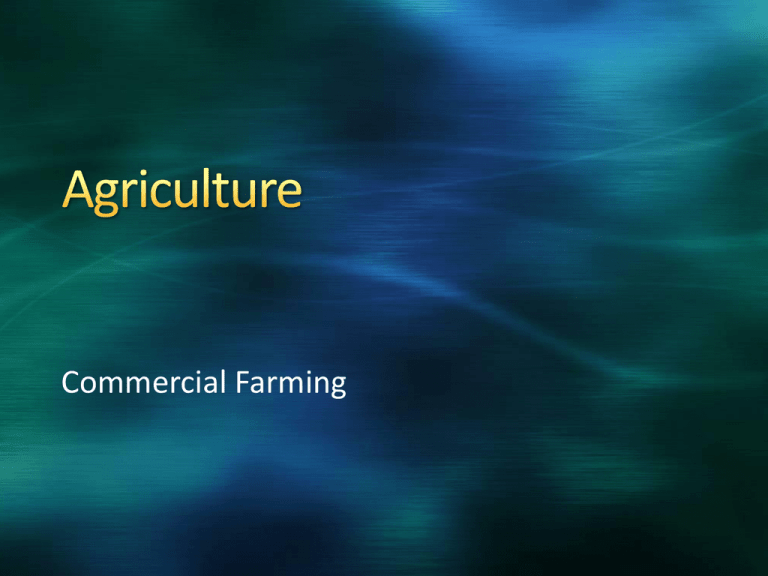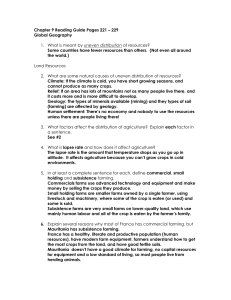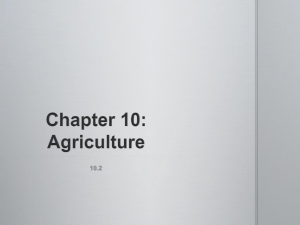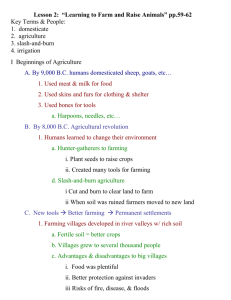Agriculture
advertisement

Commercial Farming Definition: Commercial farmers produce their crops to sell them in the marketplace Commercial farming types include mixed crop and livestock farming, ranching, dairying, and large-scale grain production Plantation farming is a form of commercial farming Mainly practiced in less developed countries Mixed Crop and Livestock farming Definition Involves a farm that grows crops and raises animals Most crops grown on mixed farms are used to feed the farm’s animals Provides manure fertilizer for sale as well as goods Most of mixed farm’s income comes from sale of its animal products Reduces farmer’s dependence on seasonal crops Devotes nearly all land to crops but 3/4ths of income comes from sale of animal products Exists widely throughout Europe and Eastern Northern America Usually farms are near large, urban areas Most mixed farms practice crop rotation Definition Commercial grazing, or the raising of animals on a plot of land on which they graze Ranching is usually extensive Practiced in areas where the climate is too dry to support crops Semi-arid, arid land Western U.S, Argentina, southern Brazil, and Uruguay In U.S. part of pop culture Cattle and sheep are most common animals on ranches Also on coast of Latin America and Northern Mexico Declining in importance Began declining in U.S. in 1880s Partly because of low grain prices and because of U.S. meat quality standards Many U.S. ranches are being converted into “fattening” farms Definition Growth of milk-based products for the marketplace Dairy farms closest to the marketplace usually produce the most perishable, fluidmilk products while those father away produce goods such as cheese and butter Most economically productive type of commercial agriculture practiced near cities in the northeastern U.S, southeastern Canada, and northwestern Europe Dairy Farms usually very small and capital intensive Uses a lot of machinery in the farming process Labor-intensive uses more human labor The milkshed is the zone around the city’s center in which milk can be produced and shipped to the marketplace without spoiling Growth in transportation technology has increased area of the milkshed Improved technology and feeding systems have led to increases in the amount of milk produced per cow Definition Where the grains are most often grown to be exported to other places for consumption Within North America, large-scale grain production is concentrated within three areas Winter-wheat belt Wheat is the dominant grain on large-scale grain farms World’s largest export crop Common in Canada, U.S., Argentina, Australia, France, England, and the Ukraine U.S. largest grain producer Kansas, Colorado, Oklahoma Spring-wheat belt Dakotas, Montana, Southern Saskatchewan Canada Palouse region Washington State Large-scale grain farms grew during Industrial Revolution Farms are usually highly mechanized, capital-intensive operations Several technological innovations precipitated the growth of largescale grain farming: McCormick Reaper 1830s Cuts standing grain in the field Combine Machine Completes all three processes: Reaping, threshing, and cleaning Definition Involves large-scale farming operations that specialize in farming of one or two high-demand crops for export, usually to more developed regions Called plantations or agricultural estates Introduced in tropical and subtropical zones by European colonizers Seeking to produce crops such as: Coffee, tea, pineapples, palms, coconuts, rubber, tobacco, sugar cane, and cotton Today, plantation farming is largely reflective of global power structures Most exist in low-latitude regions of Africa, Asia, and Latin America Most owned by companies from more developed countries Often take the best land from natives Most plantations exist in a location that has easy coastal access for export Through modern plantations have integrated advanced technology, still laborintensive Large number of seasonal workers used Form of plantation agriculture remains in the subtropical and tropical U.S. Migrant workers used for labor Predominant type of agriculture in the Southeast United States Region has a long growing season and humid climate and is accessible to the large markets New York, Philly, Washington D.C. Often called “truck farming” Truck means “bartering or exchange of commodities” Grow fruits and vegetables Sold fresh to consumers Highly efficient large-scale operations Labor costs kept down by hiring migrant workers Many undocumented Johann Heinrich von Thunen a 19th century economist Wrote book The Isolated State 1826 Formulated model to explain and predict where and why different agricultural practices would take place around a city’s marketplace What is says… Farmers consider which crops to cultivate and which animals to raise based on market location The farmer compares two costs Cost of land vs. cost of transporting goods to market Based model on assumptions Assumed there was only one city with one, central marketplace where all farmers sell their products Assumed that the farmland is all equally farmable and productive and there is only one type of transportation mode Also assumed no social customs or government policies would influence farmer’s choices Given these assumptions, von Thunen’s model allowed for only one variable to change in his model The distance a farm’s location was from the city’s market as evident in transportation costs In the model, the central marketplace is surrounded by agricultural activity zones that are in concentric rings Each ring represents a different type of agricultural land use Moving outward from the city’s central marketplace, the farming activities change from intensive to more extensive Reasons explaining the Model’s predictions Land closest to the city’s marketplace is more expensive per unit than is land farther away from the city’s center A grain farmer who needs a lot of land for his/her extensive farming operation is going to purchase a farm further away from the city’s central marketplace because the land is less expensive A milk producer is likely to buy land closer to the city’s center because he/she doesn’t need the extensive land a grainfarmer needs to produce the same profit Additionally, the dairy farm needs to be closer to the marketplace so milk can be transported to the marketplace for sale before it spoils Grazing is often the land uses farthest away from marketplace Usefulness of the Model Useful in comparing real situations to his theoretical farming situation One that is restricted to only one variable (transportation costs) chaning In the real world, agricultural land use patterns depend on more than one variable Von Thunen knew his work was based on his theoretical assumptions so he introduced some variations Existence of a river running through the city, possibility of multiple marketplaces, idea that soil was not equal everywhere in the model Overall the model emphasizes the influence of distance as a factor in human location decisions According to Von Thunen, farming decisions, like so many other spatial patterns, relate to distance






